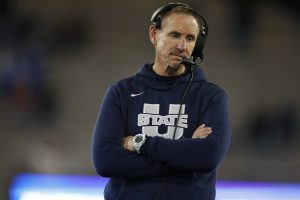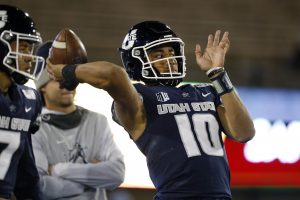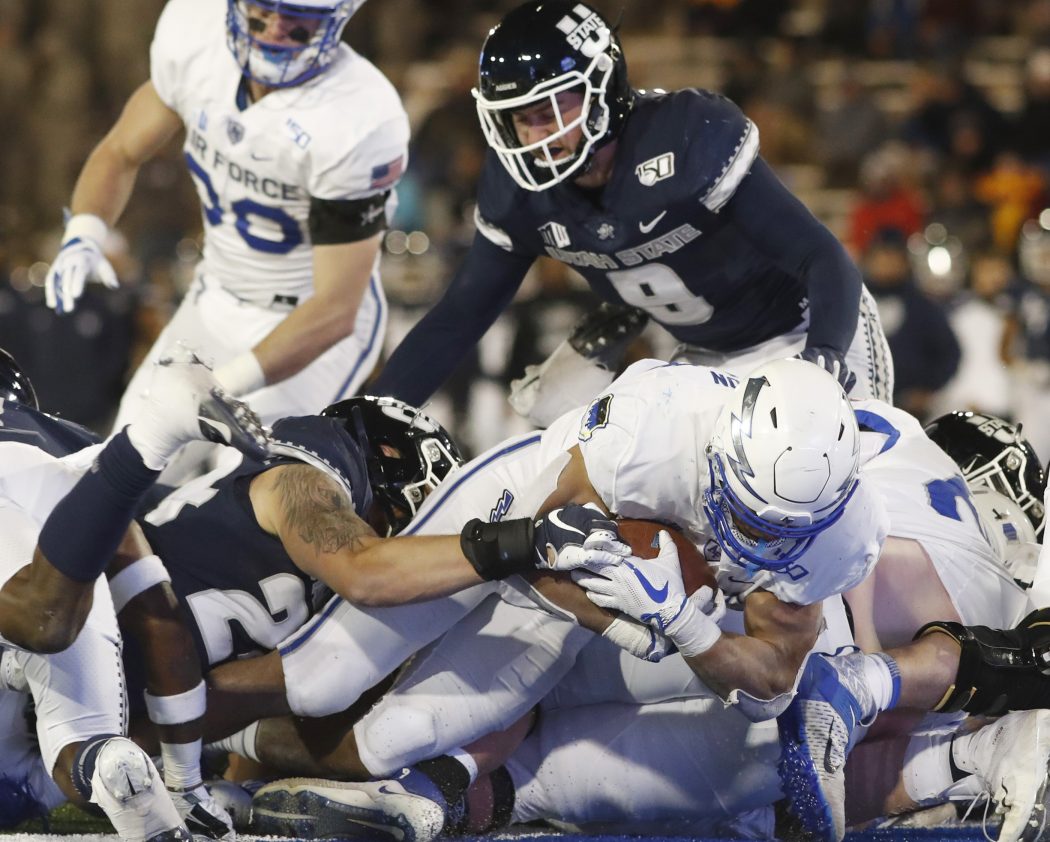Aggies bulldozed by Air Force run game, drop first MW game
In a physical sense, Utah State traveled to Colorado Springs to face Air Force in a clash of Mountain West division rivals. Mentally, the Aggies did not make an appearance on the gridiron all night as they lost their first conference game of the season 31-7.
From the opening kick to the final whistle, the Falcons dominated just about every facet of the game, a fact attested to by USU head coach Gary Andersen after the game.

Utah State head coach Gary Andersen looks on in the first half of an NCAA college football game against Air Force Saturday, Oct. 26, 2019, at Air Force Academy, Colo. (AP Photo/David Zalubowski)
“We got beat by the better team, no question about it,” Andersen said in a postgame interview on 92.3 KBLU Logan LP and 97.5/1280 The Zone. “Air Force pretty much dominated both sides of the football game.”
On offense, AFA (6-2, 4-1) ran for 285 yards in the first half alone. By the end of the night, the Aggies (4-3, 3-1) allowed 448 rushing yards, their worst defensive performance in that category since at least 2000 according to College Football Reference.
“Tonight they just got the best of us,” Aggies defensive back Shaq Bond said postgame. “They schemed against us very good. They did some things we didn’t see on film a lot. They added in some new stuff we hadn’t seen. But we adjusted well but at the same time, they got the best of us.”
That complete domination on the ground allowed Air Force to enjoy a 45:43 to 14:17 advantage in time of possession. Utah State ran just 36 plays to the Falcons’ 84. Being out on the field for such a long period of time did few favors for a defense already struggling to stop the run.
“Yea, I could say we started to wear down a little bit,” Bond said. “Not going to say a lot because we still played until the finish but it was tough being out there a lot. “
Predictably, holding on to the ball for a paltry 14 minutes and running 36 plays — the lowest play total in a single game for Utah State since at least 2000 per College Football Reference — led to, or was a product of, the Aggies’ woeful offensive performance. They gained just 128 yards on offense, the fewest since a 58-10 beatdown at the hands of the University of Utah in 2008 (116 on that day).
The offensive ineptitude has been a running theme in Aggieland for several games now. Against Colorado State, LSU and Nevada, the offense consistently failed to string together offensive drives.
“We’ve got to find a way to get some things going offensively,” Andersen said. “And until we do that, it’s going to be awfully tough to win football games.”

Utah State quarterback Jordan Love warms up before the first half of an NCAA college football game against Air Force Saturday, Oct. 26, 2019, at Air Force Academy, Colo. (AP Photo/David Zalubowski)
The passing game has been particularly decrepit during the troubling stretch. Jordan Love, began the season on a furious pace, averaging 334.3 yards per game with a 68.2 completion percentage in his first three games. In the four following games, Love has completed 60 percent of his passes in a game just once (60.8 vs AFA on Saturday) and has thrown for more than 200 yards once (204 vs CSU). All told, Love’s numbers since Sept. 22 come out to 154.3 yards per game, a 50.4 completion percentage and a 4-6 touchdown to interception ratio.
Though Utah State managed just 44 yards in the first half and went into the break down 17-0, coming out of the locker room, the team showed life. The offense took the second-half kickoff and drove 75 yards in nine plays, capped off by a 27-yard TD connection between Jordan Love and Siaosi Mariner. Additionally, the defense held Air Force to its shortest drive of the game, six plays for seven yards, forcing the first Falcons punt of the game.
That would be the only bright spot of the game on either side of the ball from then on.
Air Force’s punt was downed on the one-yard line of Utah State. One three-and-out later and the Aggies had to punt into a heavy wind, handing the ball to the Falcons with just 41 yards of turf between them and the end zone. The conclusion to that drive was almost foregone as Air Force ran the ball eight times to gain each of those 41 yards.
The touchdown drive early in the second half put Utah State down 24-7. The response to that situation by the Aggies was a five-play, 15-yard drive. In the fourth quarter, the last chance to forge a comeback, USU held the ball for all of 46 seconds prior to the team’s final drive of the game that started with 2:48 left on the game clock.
“To beat these guys…all three phases have got to contribute in a very positive way. That didn’t take place,
Andersen said. “You’ve got to be in there in the possession battle.”
Andersen added that Saturday’s performance “is not acceptable for anybody” on the staff or among those on the field. But he did place a large amount of blame upon himself and the coaches.
“When it doesn’t happen on the field you’ve got to look at us as coaches,” Andersen said. “You can’t blame it on the kids you have to put it right back on us and say we need to be able to do a better job of coaching, better job adjusting to whatever it may be.”
The loss drops Utah State to fourth in the Mountain division of the MW standings. Wyoming (6-2, 3-1), Air Force and Boise State (6-1, 3-0) all stand above the Aggies. Next week, USU will host in-state and non-conference rival BYU. The Cougars are one bye week removed from beating Boise State at home.

